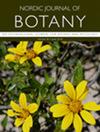稀有蛇纹石植物 Japonolirion osense(石蒜科)的授粉生物学
IF 1.1
4区 生物学
Q3 PLANT SCIENCES
引用次数: 0
摘要
矮牵牛属(Petrosaviales)是早期分化的单子叶植物纲,只包括两个具有不同营养模式的属,即自养型的 Japonolirion 和菌根营养型的 Petrosavia。Japonolirion osense 是日本特有的稀有蛇麻藤植物,也是该属的唯一物种。虽然已知 Petrosavia 物种能通过自主自花授粉产生种子,但 J. osense 的交配系统和访花者仍不为人知。本研究在日本北海道北部的一个蛇形山坡上调查了 J. osense 的授粉生物学特性。授粉实验表明,欧鼠李主要依靠昆虫授粉者的异花授粉来生产种子。蚂蚁和双翅目昆虫是该物种的主要访花者。这项研究表明,石蒜科的两个属具有不同的营养模式,它们的交配系统也截然不同,这为研究这一早期分化的单子叶植物的授粉生物学进化提供了深入的见解。本文章由计算机程序翻译,如有差异,请以英文原文为准。
Pollination biology of a rare serpentine plant, Japonolirion osense (Petrosaviaceae)
Petrosaviales is an early diverging monocot order that includes only two genera with distinct nutritional modes, namely the autotrophic Japonolirion and mycoheterotrophic Petrosavia. A rare serpentine plant endemic to Japan, Japonolirion osense is the only species of this genus. Although Petrosavia species are known to produce seeds by autonomous self-pollination, the mating system and flower visitors of J. osense remain unknown. In this study, the pollination biology of J. osense was investigated on a serpentine slope in northern Hokkaido, Japan. Pollination experiments suggested that J. osense predominantly depends on cross-pollination by insect pollinators for seed production. Ants and dipterans were the main flower visitors to this species. This study showed that the two genera in Petrosaviales with distinct nutritional modes also have contrasting mating systems, which provides insights into the evolution of pollination biology in this early diverging monocot order.
求助全文
通过发布文献求助,成功后即可免费获取论文全文。
去求助
来源期刊

Nordic Journal of Botany
生物-植物科学
CiteScore
1.90
自引率
11.10%
发文量
100
审稿时长
2 months
期刊介绍:
Nordic Journal of Botany publishes original contributions on all aspects of the taxonomy, evolution, conservation, ecology and biogeography of plants (including algae and bryophytes) and fungi.
 求助内容:
求助内容: 应助结果提醒方式:
应助结果提醒方式:


